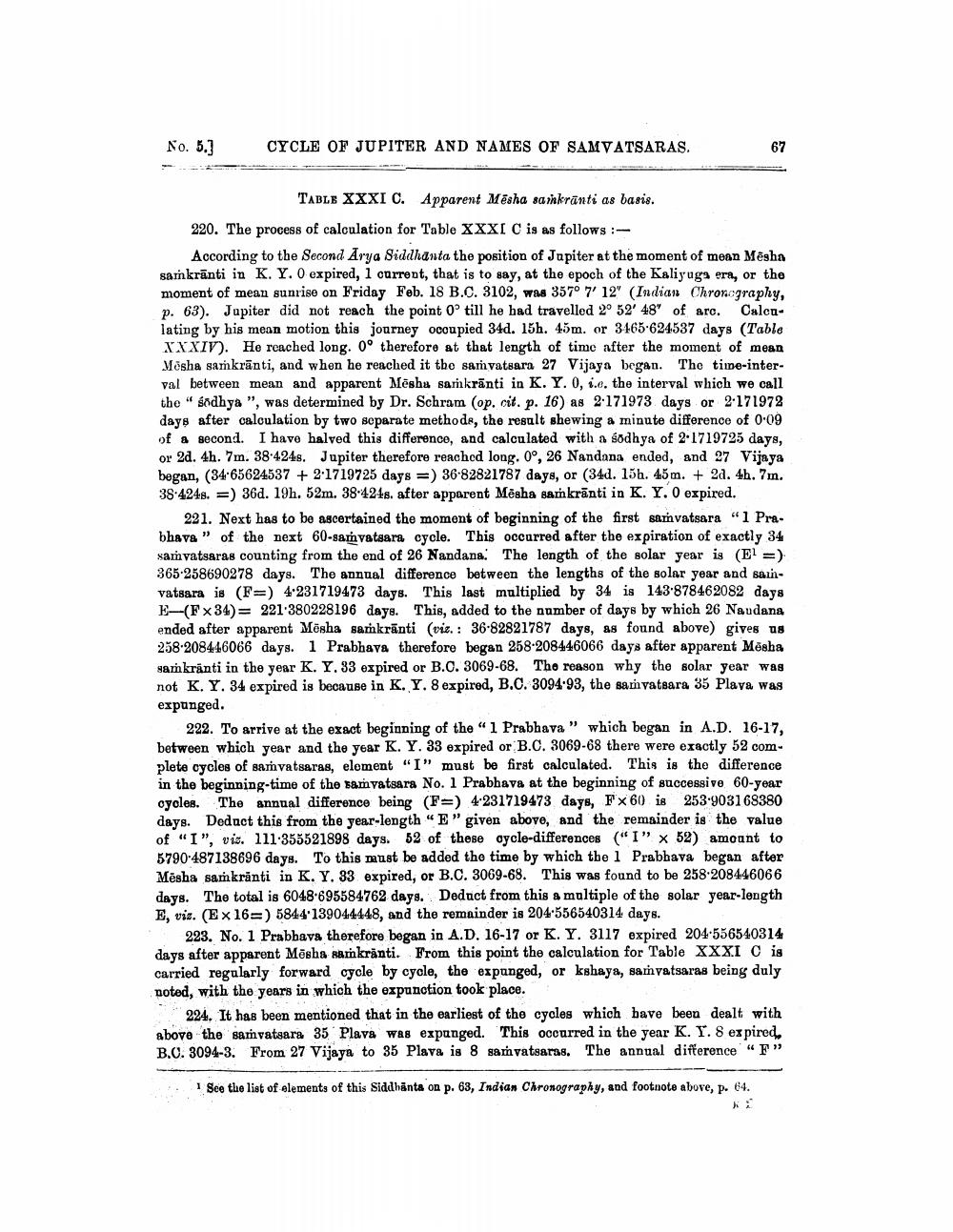________________
No. 5.]
CYCLE OF JUPITER AND NAMES OF SAMVATSARAS.
67
TABLE XXXI C. Apparent Mēsha sankrānti as basis. 220. The process of calculation for Table XXXI C is as follows:
According to the Second Arya Siddhanta the position of Jupiter at the moment of mean Mesha samkrānti in K. Y. O expired, 1 current, that is to say, at the epoch of the Kaliyugs era, or the moment of mean sunrise on Friday Feb. 18 B.C. 3102, was 357° 7' 12' (Indian Chronography, p. 63). Jupiter did not reach the point 0° till he bad travelled 2° 52' 48' of arc. Calonlating by his mean motion this journey ocoupied 34d. 15h. 45m. or 3465.624537 days (Table XXXIV). He reached long. 0° therefore at that length of time after the moment of mean Mosha samkrānti, and when he reached it the samvatsara 27 Vijaya began. The time-interval between mean and apparent Mēsha samkrānti in K. Y. O, i.e. the interval which we call the " sodhya ", was determined by Dr. Schram (op. cit. p. 16) as 2:171973 days or 2-171972 days after calculation by two separate methods, the result shewing a minute difference of 0.09 of a second. I have halved this difference, and calculated with a sodhya of 2.1719725 days, or 2d. 4h. 7m. 38.424s. Jupiter therefore reached long. 0°, 26 Nandana ended, and 27 Vijaya began, (34:65624537 + 2.1719725 days =) 36-82821787 days, or (34d. 15h. 45m. + 2d. 4h. 7m. 38-424s. =) 36d. 19h. 52m. 38-4248. after apparent Mesha samkrānti in K. Y. O expired.
221. Next has to be ascertained the moment of beginning of the first samvatsara "1 Prabhava” of the next 60-samvatsara cycle. This occurred after the expiration of exactly 34 samvatsaras counting from the end of 26 Nandana. The length of the solar year is (El =) 365-258690278 days. The annual difference between the lengths of the solar year and sainvatsara is (F=) 4.231719473 days. This last multiplied by 34 is 143-878462082 days E-(F x 34)= 221-380228196 days. This, added to the number of days by which 26 Naudana ended after apparent Mösha samkrānti (viz. : 36-82821787 days, as found above) gives us 258-208446066 days. 1 Prabhava therefore began 258-208446066 days after apparent Mēsha samkranti in the year K. Y. 33 expired or B.C. 3069-68. The reason why the solar year was not K. Y. 34 expired is because in K. Y. 8 expired, B.C. 3094.93, the samvatsara 35 Playa was expunged.
222. To arrive at the exact beginning of the “1 Prabhava" which began in A.D. 16-17, between which year and the year K. Y. 33 expired or B.C. 3069-68 there were exactly 52 complete cycles of samvatsaras, eloment "I" must be first calculated. This is the difference in the beginning-time of the samvatsara No. 1 Prabhava at the beginning of successive 60-year ayoles. The annual difference being (F=) 4.231719473 days, Fx 60 is 253.903168380 days. Deduct this from the year-length "E" given above, and the remainder is the value of "I", vis. 111.355521898 days. 52 of these cycle-differences ("I" x 52) amount to 5790-487138696 days. To this must be added the time by which the 1 Prabhava began after Mēsha samkrānti in K. Y. 33 expired, or B.C. 3069-68. This was found to be 258 208446066 days. The total is 6048-695584762 days. Deduct from this a multiple of the solar year-length E, viz. (Ex16=) 5844:139044448, and the remainder is 204556540314 days.
223. No. 1 Prabhava therefore began in A.D. 16-17 or K. Y. 3117 expired 204-556540314 days after apparent Mēsha samkranti. From this point the calculation for Table XXXI C is carried regularly forward cycle by cycle, the expunged, or kshaya, samvatsaras being duly noted, with the years in which the expunction took place.
224. It has been mentioned that in the earliest of the cycles which have been dealt with above the samvatsara 35 Plava was expunged. This occurred in the year K. Y. 8 expired B.O. 3094-3. From 27 Vijaya to 35 Plava is 8 samvatsaras. The annual difference "F"
3.
See the list of elements of this Siddhānta on p. 63, Indian Chronography, and footnote above, p. 64.




